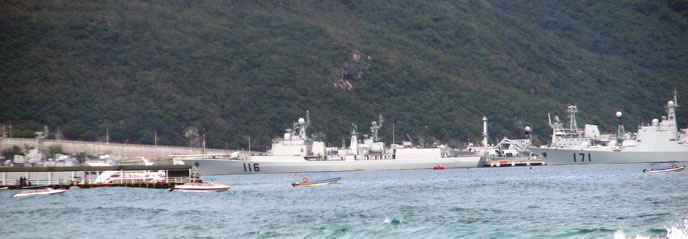
2nd Article in the 2011 Flashpoint – Asia Series | A major player in the Asian scene is the Peoples Republic of China. This rising giant is already in the midst an immeasurable and unprecedented economic growth period, but creating perpetual insatiately need for a stable and secure oil supply. Beijing’s main supply route is from the Persian Gulf, via the Indian Ocean, the Malacca Strait to China’s main ports. The nation’s primary strategic aim is obviously to secure its vital lifeline, uncompromisingly – with “money being no object”. China’s regional strategy will inevitably create considerable conflict with US global interests, challenging its superpower hegemony in this critical domain.

To understand the complexity of the enfolding strategic situation, one must contemplate China’s tremendous economic growth over the last twenty years. In just over a single decade, China’s foreign trade grew from $289 billion dollars to a staggering $2,560 billion in 2005, epitomizing with an unprecedented surge in its export volume. But there is one vital commodity that Beijing lacks: oil.
Although China was an oil exporter in its past, beginning in 1993, the explosive industrial growth and dwindling production in its own oil fields reversed that flow. Today, China is already the second largest global oil consumer behind the United States, having already surpassed Japan.
To maintain its aggressive economical growth, Beijing’s desperate quest for reliable oil supplies, and secure unfettered supply route, are its main strategic aims for the next decade. To secure these supply lines, China is pursuing the “String of Pearls” strategy, by securing forward presence and military bases along the Sea Lines of Communication (SLOCs) from China to the Persian Gulf in the Middle East.

A “pearl” normally comes with facilities like airstrips and protected naval bases. The first pearl is the Hainan Island in South China. The Chinese have already upgraded the naval base and military facilities at this location. This facility accommodates massive underground submarine and a base for large surface ships, strategically located at the South China Sea. The entrance to the submarine base are through large, 60 ft high tunnels, allowing conventional and nuclear submarines to enter or leave the base submerged, without Western spy satellites detecting their movements. The tunnels are leading to caverns that can hide up to 20 nuclear attack submarines. Two 950m piers built at the site can support two carrier battle groups.
The second pearl is the port of Hambantota in Sri Lanka. Despite fierce objection from India, Sri Lanka and China continued the development of the base, with China underwriting US$1.2 billion for the facility.

The third pearl is the Chittagong port in Bangladesh and another is located on the disputed Woody Island, located 300 miles east of Paracel archipelago. An airstrip has been upgraded at the site to support the naval facility. Similar infrastructure has been prepared at the Port of Sittwe in Myanmar, Marao in the Maldives and Port of Gwadar in Pakistan. Gwadar was chosen because of its strategic value, located only 240 km distance from the Straits of Hormuz. New Delhi fears that the Gwadar port project which is also linked to the Karakoram highway expansion project linking Western China with the Arabian sea could economically strengthen Pakistan.
The Karakoram Highway is connecting China’s Xinjiang region with Pakistan’s north. The highway, called the ‘ninth wonder of the world’ by some, because of its altitude, was completed in 1986 after 20 years of construction. The road opened up China-Pakistan trade and gave both of India’s rivals a fast route through the mountains, not far from the controversial “Line of Control” in disputed Kashmir.

According to a US Congressional Research, the ex-Soviet carrier is expected to become operational in two years as a training carrier supporting the first Chinese carrier air wing. Two additional carriers to be built in China will be available to China by 2017 and will patrol the South China Sea, Western Pacific and Indian Ocean. By 2015 the Chinese submarine force will be nearly double the size of the U.S, and the entire Chinese naval fleet is expected to surpass the size of the U.S fleet – the report claims. (Recently a Hong Kong newspaper confirmed the existence of the Chinese carrier program, citing official Chinese sources)In 2009 Beijing concluded its plans to build a large “Blue Water Fleet”. From the north to south of China Chinese shipyards are working round-the-clock building military surface vessels. US Naval Intelligence is saying that ‘China currently is building nuclear-powered aircraft carriers. One aircraft carrier – Varyag, bought as a surplus Kuznetsov class carrier from Russia – is already under construction in Dalian shipyards. The new carriers could be built at the newly expanded Jiangnan Shipyard, at the Changxing Dao island off Shanghai.

By December 2010 Varyag was moved to an open position along the pier, adjacent to the dry dock shown above. The construction of the island has been completed and all major upgrades seem to be completed, as the ship is prepared for its relaunching. Photo: Eros B satellite by Imagesat International BV
2011 Flashpoints: Asia features include the following topics:
- Competing for regional Hegemony
- ‘String of Pearls’ is Securing China’s Sea Lanes
- India Bolsters its Navy to Face the Growing Chinese threat
- The Chinese Dragon vs the Indian Tiger
















